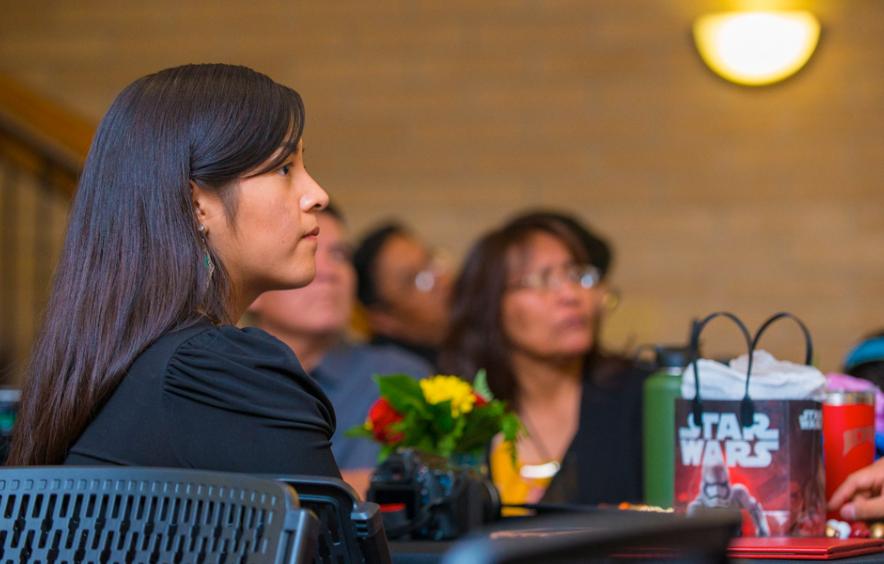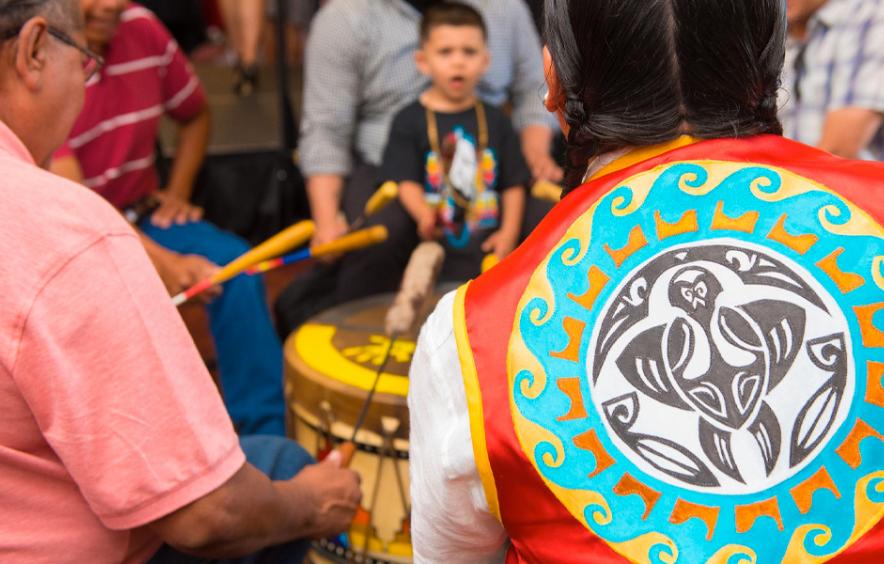Native American Pedagogies

This Native American Pedagogy module offers information and guiding cultural context to design welcoming academic spaces for teaching and learning. Many people are unconsciously subscribing to “a worldview that reflexively considers indigenous cultures and ways of knowing as other or alternative or exotic or primitive” (Merculieff & Roderick, 2013). Native American students are then required to develop resilience to navigate stressful situations in higher education classrooms (Waterton, 2013).
Critical theory is crucial to understanding the relationship and influence higher education has on Native Americans. Recent research on Native American college students has found family, culture, and community as well as faculty support as critical to student success and retention (Waterton, 2013; Marroquin & McCoach, 2017). With this in mind, we invite you to explore the resources on this page and incorporate many of the suggested approaches into your teaching practices.
This article covers:
- Introduction
- Teaching Practices
- Resources
What are Native American Pedagogies?
Place-Based Learning
Place-based education promotes learning experiences that are rooted in the cultural, historical, environmental, economic and literary contexts of students. As such, it is critical to understand the ways that culture and place are intrinsic to the experiences of Native students and other populations. This framework provides faculty with an applicable set of best practice strategies to incorporate into the classroom and serve an array of students (Conti, 2013).
All-Senses Experiential Learning
Experiential learning in the Alaska Native way uses all the senses: sight, hearing, taste, touch, and smell, plus intuition and gut feeling. This framework recognizes that young people learn through engagement in activities that support their community in cooperative, collaborative and intentional ways that increase memory and skill development (Merculieff & Roderick 2013).
Storytelling
Storytelling is central to the learning of indigenous peoples. Stories convey information about history, survival, culture, and are used as a formative corrective method when an individual creates disharmony in the community. In this latter example, Elders may choose to tell a corrective story without criticizing, singling out or disciplining an individual knowing that lessons will be remembered better if they are conveyed in an animated style (Merculieff & Roderick 2013). Consider how you might incorporate case studies, biographies, fiction, and oral history in your course.
Tribal Critical Race Theory
Tribal Critical Race Theory or TribalCrit examines Native experiences about Colonialism. It is deeply rooted in Critical Race Theory Education and thus examines the impact of race and racism (Zamudio, 2011). TribalCrit has nine tenets that can help guide how we support about Native Students in the classroom (Brayboy, 2006 pp. 429-430):
- The decentering of Indigenous ways of knowing is linked to endemic Colonization.
- U.S. policies toward Indigenous peoples are rooted in imperialism, White supremacy, and a desire for material gain.
- Indigenous peoples occupy a liminal space that accounts for both the political and racialized natures of our identities
- Indigenous peoples have a desire to obtain and forge tribal sovereignty, tribal autonomy, self-determination, and self-identification.
- The concepts of culture, knowledge, and power take on new meaning when examined through an Indigenous lens.
- Tenets toward Indigenous peoples are intimately linked to the problematic goal of assimilation.
- Tribal philosophies, beliefs, customs, traditions, and visions for the future are central to understanding the lived realities of Indigenous peoples, but they also illustrate the differences and adaptability among individuals and groups.
- Stories are not separate from theory; they constitute theory and are, therefore, real and legitimate sources of data and ways of being.
- Theory and practice are connected in profound and explicit ways such that scholars must work towards social change.
Key Definitions

Native American, Alaskan Native, and 1st Nations
These terms relate to Indigenous people across America and are used interchangeably with “American Indian” when referring to America specifically.

Place-Based Learning
A framework for incorporating cultural standards and related practices as the framework for integrating indigenous knowledge and physical environment into Western education systems (Emekauwa, 2004).

Tribal Sovereignty
This is an ambiguous term to define in a sentence as there is so much history behind the concept. Essentially, tribal sovereignty is the right for tribes to govern themselves within US borders. Please see the cited reading for more information on tribal sovereignty in both historical and modern-day settings and the implications of the term (Cobb, 2005).

Indigenous Ways of Knowing
This term relates to an alternate paradigm to occidental epistemology and ontology. According to Harris (2002), many Indigenous people view every aspect of creation as continuously interacting with one another. As the observer is interacting with the observed, objectivity is impossible as the two cannot be separated.

Culturally Relevant
Enabling students to relate course content to their cultural context through pedagogical methods. Developing cultural relevance in the classroom to create transcultural students. Recognizing cultural values and spiritual identities.

Teaching Tools
Classroom Participation
Many Native American students come from a culture that doesn't challenge authority. They may not feel comfortable expressing an opinion, especially if it differs from the faculty member’s opinion. They may have experienced learning in their home community through observation, supervised participation, and private self testing. They may feel more comfortable participating in class after they have had time to consider their responses or practice their skills (Pewewardy, 1998).
Consider your assumptions if a student is observing silently and does not speak up in class. It may be helpful to design varied methods of participation credit, including written responses submitted after a class discussion. If a student offers ideas in these written responses that can forward the class discussion, ask for permission to share this idea at the next class session. Make sure not to ask a Native American student to represent their community’s values and history. Let them share their cultural background and perspective by choice.
If I could give you some advice, I’d tell you to organize more lessons around stories. Develop incisive questions that invite students to think deeply about the issues presented in the stories and how they apply to their lives and relationships. Make stories out of every kind of lesson you wish to convey. Ilarion (Larry) Merculieff and Libby Roderick, “Stop Talking, Indigenous Ways of Teaching and Learning and Difficult Dialogues in Higher Education"
Classroom Strategies
Specific strategies for fostering an inclusive environment that recognizes and supports the history, identity, and ways of knowing of our Native American students.
-
Reflect on any preconceived stereotypes you may have.
- Remember that Native students are misjudged according to their ability and often feel as though they are viewed through a deficit lens (Taylor, 2001).
- Have there been times when you have looked at students through a deficit lens in your teaching?
- Are there any aspects of students you have misjudged?
- What can you do to reframe your thinking?
-
Do not “other” the student.
- Have there been times when you have asked a student to act as a representative of their culture?
- How does your course further stereotype and marginalize communities through the use of specific materials?
- What kinds of support do you have in place to help students in the classroom?
-
Acknowledge that Native students may have different values.
- Native students have a different history and thus have a different view of knowledge and understanding.
- According to Brayboy (2006, p. 430), "the concepts of culture, knowledge, and power take on new meaning when examined through an Indigenous lens."
- The community is at the core of existence for many Native Americans which stand in direct opposition to Western paradigms of Individualism (Waterman & Lindley, 2013).
- How have you facilitated the inclusion of new perspectives into your classroom without spotlighting or tokenizing students? For example, Colonized history states, "Christopher Columbus discovered the Americas." However, Native Students question: Our ancestors were already here, how do you discover a place where people were already living?
-
Incorporate storytelling into the classroom.
- Stories and theory are not considered separate and are linked with each other (Brayboy, 2006).
- When Native American students frame their world by sharing their knowledge from family or stories that have been passed down from their culture and are legitimate theoretical sources.
- A Native student might share a personal story in class about their life and how it has framed their reality.
- A Native student might talk about what they have learned from their families and elders. Understand this is a valid way of understanding knowledge.
-
Incorporate instructional conversation into the classroom.
- Instructional conversation is a method in which dialogue is created between the instructor and the learner to allow for lived experiences to be woven into course material. This allows for a higher understanding of the material because it is presented in a culturally relevant way.
- Instructional conversation as a teaching method allows for the incorporation of Indigenous ways of knowing without making changes to the curriculum.
-
Recognize different forms of spirituality.
- The concept of the word "religious" does not apply to Native American spirituality.
- No two ceremonies are the same, and some tribes may not be able to participate in certain Native ceremonies due to different beliefs.
- Understand that there are many Native Americans that adopted western religions including Christianity, Catholicism, Baptist, etc., through colonialism.
- It is not safe to assume the beliefs of Native students or assume that Native students come with a full traditional understanding of their nation’s spirituality (see Spiritual and Religious diversity considerations in this Portal).
- Attempt to understand each individual student and what each person hopes to get from the class and how the course will help them in the future.

Supportive Resources

DU Native American Task Force
The University of Denver’s Native American Task Force addresses issues of educational equity as it relates to Native students at DU. Chancellor Emerita Rebecca Chopp has reaffirmed the University's commitment to the sustainable development of a Native American community presence at the University through the following guiding questions:
- How can we support Native students enrolled at the University of Denver?
- How might we fulfill our mission to serve the public good relative to Native communities?
- How might we expand our education efforts to encourage students to make ethical decisions, to respect those who are different from them, to remember the past, and to shape a future in which Native students experience healing, and where atrocities do not recur in this land or elsewhere?
Videos
-
References
Brayboy, B. (2005). Toward a Tribal Critical Race Theory in Education. Urban Review: Issues and Ideas in Public Education, 37(5), 425-446.
Cobb, A. (2005). Understanding Tribal Sovereignty: Definitions, Conceptualizations, and Interpretations. American Studies, 46(3/4), 115-132.
Emekauwa, E. (2004). The star with my name: The Alaska rural systemic initiative and the impact of place-based education on native student achievement. Rural Trust Paper on Place-Based Education.
Merculieff, I. & Roderick, L. Stop Talking (2013). Indigenous Ways of Teaching and Learning and Difficult Dialogues in Higher Education. University of Anchorage, Alaska.
Pewewardy, C. (1998) Fluff and Feathers: Treatment of American Indians in the Literature and the Classroom, Equity & Excellence, 31:1, 69-76
Shield, R. (2004). The Retention of Indigenous Students in Higher Education: Historical Issues, Federal Policy, and Indigenous Resilience. Journal of College Student Retention, 6(1), 111-127.
Taylor, J. (2001). Through a Critical Lens Native American Alienation from Higher Education. S.l.]: Distributed by ERIC Clearinghouse.
Waterman, S. J., & Lindley, L. S. (2013). Cultural Strengths to Persevere: Native American Women in Higher Education. NASPA Journal About Women in Higher Education, 6(2), 139-165.
Zamudio, M. (2011). Critical Race Theory Matters: Education and Ideology. Routledge.
Special Contribution
This module was researched and drafted by Viki Eagle, Sarah Jordon, and Jeremiah Johnson, graduate students in the Morgridge College of Education Higher Education Program at the University of Denver.
-
Suggested Citation
Iturbe La-Grave, V., Eagle, V., Jordon, S., & Johnson, J. (2020). Native American Pedagogies Module. Retrieved from http://inclusive-teaching.du.edu/native-american-pedagogies.

